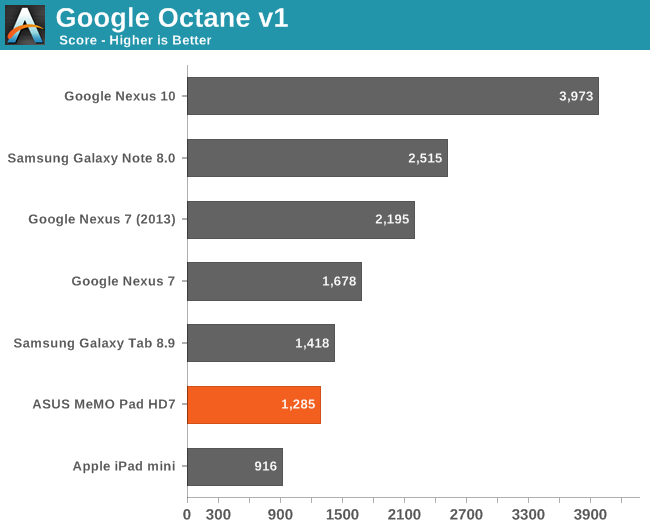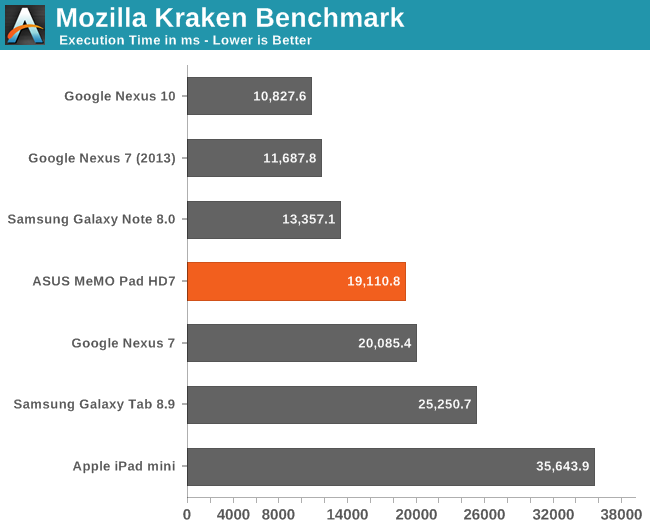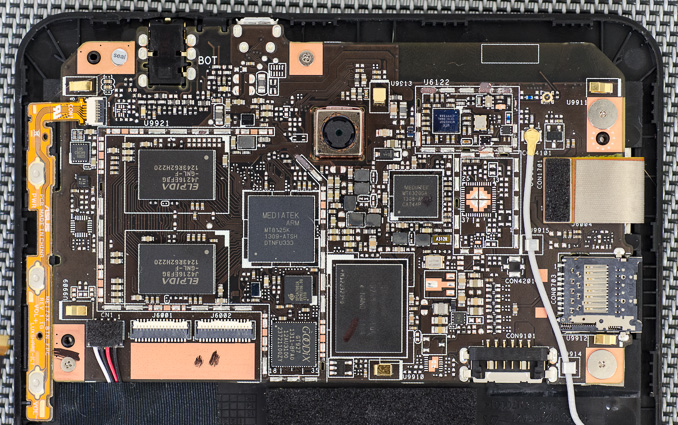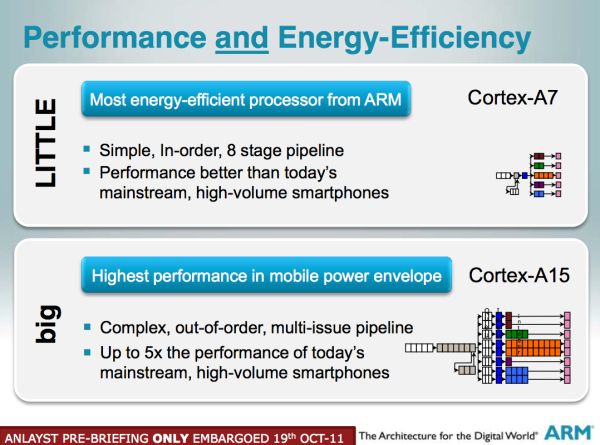ASUS MeMO Pad HD7 Review: $149 Nexus 7.1 Successor & Our First Look at MediaTek's MT8125
by Anand Lal Shimpi on July 29, 2013 3:55 PM EST- Posted in
- Tablets
- Asus
- Mobile
- Android 4.2
- MeMO Pad
MediaTek MT8125 Inside
To hit its $129/$149 price point, ASUS outfitted the MeMO Pad HD7 with a quad-core Cortex A7 based SoC from MediaTek: the MT8125. Before we get to the specifics of this SoC, it's important to put MediaTek in perspective since this is the first time we've ever reviewed one of its SoCs.
In our SoC coverage at AnandTech we tend to focus on the big five: Apple, Intel, NVIDIA, Qualcomm and Samsung. TI dropped out of the AP (Application Processor) space, and ST-E's future as a company is a bit uncertain. The benefit of ARM's business model however is that anyone can put its cores and/or ISA to use. You just need to have enough funding to pay for an ARM license and build an implementation team to get your SoC off the ground. While we're used to low cost markets being addressed by de-featured versions of high-end chips, in the ARM ecosystem there's another solution: the rise of the high-volume, low cost SoC vendor.
MediaTek, a Taiwan based fabless semiconductor manufacturer, is one of a number of ARM licensees that are presently giving Qualcomm (and other mobile SoC vendors) a hard time. They tend to take vanilla ARM (and 3rd party) IP, integrate it, and sell it for much less than the ARM licensees we're used to covering. Just as ARM's licensees are putting incredible pressure on Intel's margins in client computing, MediaTek is doing the same to the bigger ARM licensees.
Last year MediaTek shipped just under 1.7 billion chips. Granted that's across all markets that it serves (including APs, WiFi, GPS, DVD/BD player chipsets, etc…), but it's still tremendous volume.
If you look at any of the sub-$150 Android tablets these days, they all integrate some form of ultra low cost silicon. In large, cost-sensitive markets (e.g. China), MediaTek's presence is extremely high.
The MT8125 integrates four relatively early revision ARM Cortex A7 cores (r0p2). Each core can run at between 500MHz and 1.2GHz, and each core can be hot-plugged independently. I ran a bunch of low level memory tests and it looks like MediaTek opted for a fairly sensible 32KB/32KB L1 cache configuration (I$/D$). The L2 cache appears to be 1MB in size, shared between all four cores. NEON is supported.
Of the four cores, I noticed the first two are frequently active, with clock speeds usually up at 1.2GHz whenever you're doing anything (loading apps, scrolling, etc…). The third core usually plugs in to keep responsiveness up while doing anything more CPU intensive. The fourth core seems to occasionally get plugged during normal, non-heavily threaded use, but even then for very short periods of time.
We've only briefly discussed ARM's Cortex A7 here, so I'll offer some more details on the architecture since it's relevant. The Cortex A7 is ARM's Cortex A5 successor. It's a light-weight 32-bit core that is fully ISA compatible with the Cortex A15 (which is why we see it used in big.LITTLE configurations with the A15). The A7 is a fully in-order micro-architecture, unlike the OoO Cortex A9 (at least with respect to integer instructions). The A7's integer pipe is 8 stages deep, and has limited dual-issue capabilities (e.g. FP/NEON can't be dual-issued, branches can only be issued from one port, etc…). The execution back end is quite similar to the Cortex A8.
ARM's goal with the Cortex A7 was to deliver similar performance to the Cortex A8, but in a smaller area and at lower power. ARM claims a single Cortex A7 core could be fit into a 0.5mm^2 area on a modern 28nm process. That's roughly 1/6 the area required to implement a single AMD Jaguar core.
Feeding the quad-core Cortex A7 cluster is a single-channel (32-bit wide) DDR3L memory interface. ASUS opted for two 16-bit DDR3L-1066 devices on-board. My review sample used Elpida DDR3L, the same type found in iFixit's teardown of the new Nexus 7.
Performance in our standard suite of web based tests has the quad-core Cortex A7 MT8125 trading blows with the quad-core Cortex A9 Tegra 3 in the Nexus 7. When the two are similar, they tend to be pretty close, but when there's a lopsided victory it's usually well in favor of the Tegra 3/Nexus 7. That tends to mirror my experience with the MeMO Pad HD7. In many cases it feels close to the 2012 Nexus 7's performance, but there's an element of snappiness that's just not present. Some Android animations are a little choppier (e.g. bringing up the apps grid) compared to the Nexus 7. I do wonder how good MediaTek's memory controller implementation is. Remember that ARM only has to provide the CPU IP, the rest of the SoC is up to the designer to build/source.















75 Comments
View All Comments
rabidpeach - Tuesday, July 30, 2013 - link
considering sdhx is mostly a microsoft invention, it might not be well supported in the android universeMonkeyPaw - Monday, July 29, 2013 - link
The big issue now is that places will be clearing Nexus 7.1 stock out. I already see the 16GB listed for $170 (or less for refurbs). You can get a 32GB N7.1 for $199 at Microcenter.Death666Angel - Monday, July 29, 2013 - link
I guess people who want the Nexus experience will still get a Nexus, people who want mSD support, a rare facing camera and a lighter chassis will get the HD 7. And other markets are different as well, here in Germany, the N7 2012 is still at the normal prices: 199€ for the 16GB one over the Play Stor, 238€ for the 32GB one at a normal store with the Play Store being 249€. That makes the HD 7 a lot cheaper, white being 139€ and the rest being 149€, that's not much absolutely, but relatively quite the pay up to get an N7. :)nafhan - Monday, July 29, 2013 - link
So... unless the MicroSD slot is really important, the best bet for bargain hunters may be to look for a deal on last year's N7. I've seen those hit this price point a few times (new).blanarahul - Monday, July 29, 2013 - link
"Like most other quad-core implementations in Android, I rarely see the fourth core turn on. The first two are frequently active, with clock speeds usually up at 1.2GHz whenever you're doing anything (loading apps, scrolling, etc…). The third core usually plugs in to keep responsiveness up while doing anything more CPU intensive, but that fourth core is almost never plugged."I would like to ask. Under what conditions does the 4th core get plugged? How many cores ate used while playing games like Modern Combat 4?
Anand Lal Shimpi - Monday, July 29, 2013 - link
I updated that paragraph a bit to be more specific to the MT8125/MeMO Pad HD7. MC4 tends to use 2 cores from what I've seen:http://images.anandtech.com/doci/7160/Screenshot_2...
peter23 - Monday, July 29, 2013 - link
Maybe all cores might get used if you're streaming music, downloading a torrent and using the nav all at the same time. All cores could get used if you find a video that can only be decoded in software. I don't use Chrome but maybe each tab also uses a separate process like the desktop one. I sometimes open up multiple tabs right after each other and maybe each core will be used to process each tab. These are all guess because I only have a dual-core phone.agentsmithitaly - Monday, July 29, 2013 - link
I'm very happy to see only metric measures except screen diagonals, you guys really listen to your audience!Now what about an Allwinner soc review? Hard to get excited from a performance point of view, but it's amazing to see working 50 $ tablets
abrowne1993 - Monday, July 29, 2013 - link
I feel like there is so much going on in that title.jjj - Monday, July 29, 2013 - link
You should try to find and test a product with Rockchip RK3188 , quad A9 on 28nm with just 25mm2 die size - very curious how it performs and at that size it got to be way cheap.